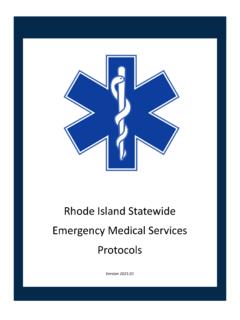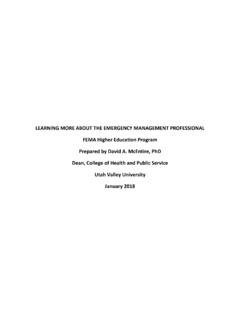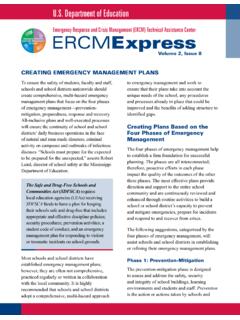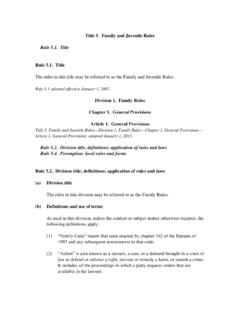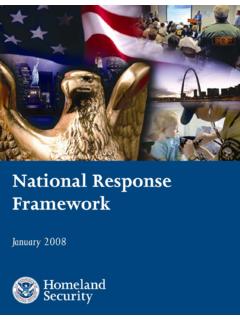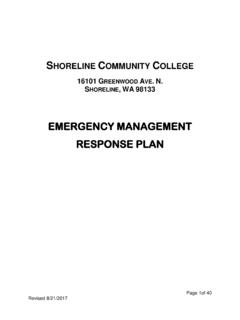Transcription of Military Operations Army Emergency Management Program
1 UNCLASSIFIED Army Regulation 525 27 Military Operations Army Emergency Management Program Headquarters Department of the Army Washington, DC 29 March 2019 SUMMARY of CHANGE AR 525 27 Army Emergency Management Program This major revision, dated 29 March 2019 o Updates all-hazards Emergency Management roles and responsibilities (chap 2). o Expands Emergency Management responsibilities for mass warning and notification (chap 2). o Revises installation Emergency Management typing designations from four to five types: Type I (Technician), Type II ( Operations ), Type III (Awareness), Type IV (Baseline), and Type V (Exempt) (chap 3). o Updates requirements for Emergency Management Program manager, Emergency Management coordinators, and Emergency managers (chap 4). o Provides guidance for stand-alone (off-installation) facilities and Emergency Action Plans (chap 5). o Updates all-hazards Emergency Management planning (chap 5). o Clarifies all-hazards community preparedness and protection requirements (chap 6).
2 O Delineates Army Emergency Management policy in relation to the National Incident Management System and Supporting Incident Command System (chap 7). o Updates mass warning and notification alert and incident notification requirements (chap 9). o Establishes Emergency Management responsibilities for installation Emergency Operations centers (chap 10). o Establishes installation mass care and evacuation guidance in support of DODI (chap 10). o Updates Emergency Management training requirements (chap 11). o Establishes installation Emergency Management capability, life cycle Management , and sustainment (chap 12). o Incorporates Army Directive 2017 07 7, (Prioritizing Efforts-Readiness and Lethality (Update7)); updates Emergency Management exercise requirements (chap 13). o Updates response Operations (chap 16). o Establishes Emergency Management Program medical and public health requirements in support of DODI (chap 17). o Updates assessment considerations, to include development of tenant Emergency action plans (chap 18).
3 O Adds internal control process and provisions and identifies key internal controls that must be evaluated (app B). *This publication supersedes AR 525-27, dated 13 March 2009. AR 525 27 29 March 2019 UNCLASSIFIED iii Headquarters Department of the Army Washington, DC *Army Regulation 525 27 29 March 2019 Effective 29 April 2019 Military Operations Army Emergency Management Program History. This publication is a major revi-sion. Summary. This regulation aligns Army policy with DODI and AR 525 2. Applicability. This regulation applies to the Regular Army, the Army National Guard/Army National Guard of the United States, and the Army Reserve, unless otherwise stated. Specifically, this regula-tion applies to all personnel, organizations, and contractors that have or will have the responsibility to prevent, protect, mitigate the potential effects of, respond to, or re-cover from all natural, technological, hu-man-caused hazards, including terrorism threats or incidents on or impacting any Army installation, facility, or activity worldwide.
4 It also applies to all Department of Defense personnel; Department of De-fense and non-Department of Defense ten-ants; transient Department of Defense and Government personnel; and depend-ents of Department of Defense personnel, Department of Defense contractors, visi-tors, local, or private authorities or organi-zations and guests living or working on Army installations worldwide. In the event of conflict between this regulation and ap-proved Office of the Secretary of Defense or Joint Chief of Staff publications, the pro-visions of the latter apply. Proponent and exception authority. The proponent of this regulation is the Dep-uty Chief of Staff, G 3/5/7. The proponent has the authority to approve exceptions or waivers to this regulation that are consistent with controlling law and regulations. The proponent may delegate this approval au-thority, in writing, to a division chief within the proponent agency or its direct reporting unit or field operating agency, in the grade of colonel or the civilian equivalent.
5 Activ-ities may request a waiver to this regulation by providing justification that includes a full analysis of the expected benefits and must include formal review by the activ-ity s senior legal officer. All waiver re-quests will be endorsed by the commander or senior leader of the requesting activity and forwarded through their higher head-quarters to the policy proponent. Refer to AR 25 30 for specific guidance. Army internal control process. This regulation contains internal control provi-sions in accordance with AR 11 2 and identifies key internal controls that must be evaluated (see appendix B). Supplementation. Supplementation of this regulation and establishment of agency, command, and installation forms are pro-hibited without prior approval from Deputy Chief of Staff, G 3/5/7 (DAMO AP), 400 Army Pentagon, Washington, DC 20310 0400. Suggested improvements. Users are invited to send comments and suggested improvements on DA Form 2028 (Recom-mended Changes to Publications and Blank Forms) directly to Headquarters, Depart-ment of the Army, Deputy Chief of Staff, G 3/5/7 (DAMO AP), 400 Army Penta-gon, Washington, DC 20310 0400.
6 Committee Management . AR 15 1 requires the proponent to justify establish-ing/continuing committee(s), coordinate draft publications, and coordinate changes in committee status with the Army Re-sources and Programs Agency, Department of the Army Committee Management Of-fice (AARP ZA), 9301 Chapek Road, Building 1458, Fort Belvoir, VA 22060 5527. Further, if it is determined that an established group" identified within this regulation, later takes on the characteristics of a committee, as found in the AR 15 1, then the proponent will fol-low all AR 15 1 requirements for establish-ing and continuing the group as a commit-tee. Distribution. This regulation is available in electronic media only and is intended for the Regular Army, the Army National Guard/Army National Guard of the United States, and the Army Reserve. Contents (Listed by paragraph and page number) Chapter 1 Introduction and Policies, page 1 Purpose 1 1, page 1 References and forms 1 2, page 1 Explanation of abbreviations and terms 1 3, page 1 Responsibilities 1 4, page 1 Records Management (recordkeeping)
7 Requirements 1 5, page 1 Contents Continued ii AR 525 27 29 March 2019 Statutory authority 1 6, page 1 Applicability 1 7, page 2 Policy 1 8, page 2 Chapter 2 Responsibilities, page 3 Chief, Information Officer/ G 6 2 1, page 3 Chief of Public Affairs 2 2, page 3 Chief, National Guard Bureau 2 3, page 3 Deputy Chief of Staff, G 1 2 4, page 5 Deputy Chief of Staff, G 2 2 5, page 5 Deputy Chief of Staff, G 3/5/7 2 6, page 5 Deputy Chief of Staff, G 4 2 7, page 6 Deputy Chief of Staff, G 8 2 8, page 7 Assistant Chief of Staff for Installation Management 2 9, page 7 The Surgeon General 2 10, page 7 Provost Marshal General 2 11, page 8 Commanding General, Army Training and Doctrine Command 2 12, page 8 Commanding General, Army Materiel Command 2 13, page 8 Commanding General, Army Cyber Command 2 14, page 8 Commanding General, Army Medical Command 2 15, page 8 Commanding General, Army Corps of Engineers 2 16, page 9 Commanders of Army commands, Army service component commands, and direct reporting units 2 17, page 9 Commanders of Army service component commands 2 18, page 11 Senior commanders 2 19, page 11 Commanders of government-owned, contractor-operated facilities 2 20, page 13 Installation Emergency Manager 2 21, page 13 Command Emergency Management Program Coordinator 2 22, page 13 Public Health Emergency Officer 2 23, page 13 Chapter 3 Concept of Operations , page 14 Overview 3 1, page 14 Operational construct 3 2, page 14 Installation type designations 3 3, page 14 Chapter 4 Program Management , page 15 Program administration 4 1, page 15 Headquarters, Department of the Army, G 34 Emergency Management Program manager 4 2, page 15 Emergency Management coordinator 4 3, page 15 Emergency manager 4 4, page 16 Standard installation organization 4 5, page 16 Advisory committees 4 6.
8 Page 16 Program maintenance 4 7, page 16 Chapter 5 Emergency Planning, page 17 Emergency planning concept 5 1, page 17 Installation Emergency Management plan 5 2, page 17 Risk Management process 5 3, page 18 Community profile concept 5 4, page 19 Tenant Emergency action plan 5 5, page 19 Standalone facility Emergency action plan 5 6, page 19 Additional planning elements 5 7, page 19 Contents Continued AR 525 27 29 March 2019 iii Chapter 6 Preparedness Activities, page 20 Installation preparedness 6 1, page 20 Interagency coordination 6 2, page 20 Community awareness 6 3, page 20 Interoperability 6 4, page 20 Emergency public information 6 5, page 20 Civil support 6 6, page 20 Chapter 7 National Incident Management System, page 21 National Incident Management System overview 7 1, page 21 Phased implementation 7 2, page 21 Maintenance and reporting 7 3, page 21 Resource Management 7 4, page 21 Chapter 8 Continuity Programs, page 22 Continuity programs 8 1, page 22 Business continuity 8 2, page 22 Continuity service providers 8 3, page 23 Chapter 9 Command, Control, and Communications, page 23 Incident and unified command systems 9 1, page 23 Multi-agency coordination system 9 2, page 23 Installation Emergency Operations centers 9 3, page 23 Installation dispatch centers 9 4, page 23 Mass warning and notification 9 5, page 23 Enhanced 911 9 6, page 24 Emergency communications 9 7, page 24 Public information system 9 8, page 24 Chapter 10 Evacuation Management and Mass Care Operations , page 25 Evacuation Management 10 1, page 25 Mass care Operations 10 2, page 25 Emergency Family Assistance Center 10 3, page 25 Shelter-in -place 10 4, page 25 Safe havens 10 5, page 26 Pre-existing shelters 10 6, page 26 Civilian shelter coordination 10 7, page 26 Mass feeding stations 10 8.
9 Page 26 Bulk distribution 10 9, page 26 Call center 10 10, page 26 Chapter 11 Education and Training, page 26 Training and education strategy 11 1, page 26 Senior leader orientation 11 2, page 27 Garrison commander training 11 3, page 27 Category 1 personnel training 11 4, page 27 Category 2 4 personnel training 11 5, page 27 Category 5 personnel training 11 6, page 28 Chapter 12 Equipment Fielding and Sustainment, page 30 Contents Continued iv AR 525 27 29 March 2019 Equipment acquisition, fielding, and integration 12 1, page 30 Emergency Management equipment overview 12 2, page 30 Category 1 5 personnel equipment 12 3, page 31 Equipment total life cycle systems Management 12 4, page 31 Installation role in life cycle Management 12 5, page 31 Army Tank-automotive and Armaments Command role in life cycle Management 12 6, page 31 Program Objective Memorandum/ Program funding 12 7, page 31 Chapter 13 Exercise and Evaluation, page 31 Exercise and evaluation concept 13 1, page 31 Exercise cycle 13 2, page 32 Exercise goals 13 3, page 32 Exercise planning 13 4, page 32 Exercise evaluation 13 5, page 32 Chapter 14 Mitigation Activities, page 33 Mitigation concept 14 1, page 33 Mitigation planning 14 2, page 33 Public works 14 3, page 33 Information Management 14 4, page 33 Tenant organizations and commercial businesses 14 5, page 33 Infrastructure coordination 14 6, page 34 Chapter 15 Prevention Activities, page 34 Prevention concept 15 1, page 34 Prevention strategy 15 2, page 34 Prevention planning 15 3, page 34 Chapter 16 Response Operations , page 34 Response strategy 16 1, page 34 Incident notification 16 2, page 34 Incident reporting 16 3, page 34 Incident Management 16 4, page 35 Response team organization 16 5, page 35 Chapter 17 Recovery Operations .
10 Page 35 Recovery strategy 17 1, page 35 Recovery priorities 17 2, page 35 Recovery organization 17 3, page 35 Emergency public information 17 4, page 35 Public safety considerations 17 5, page 35 Occupational safety considerations 17 6, page 35 Public health considerations 17 7, page 36 Environmental considerations 17 8, page 36 Psychological considerations 17 9, page 36 Recovery capabilities 17 10, page 36 Housing recovery 17 11, page 36 Assistance Program 17 12, page 36 Chapter 18 Capability Assessment and Accreditation, page 37 Overview 18 1, page 37 Contents Continued AR 525 27 29 March 2019 v Assessments 18 2, page 37 Emergency Management accreditation 18 3, page 37 Appendixes A. References, page 38 B. Internal Control Evaluation, page 44 Table List Table 11 1: Army Emergency Management training requirements, page 28 Glossary AR 525 27 29 March 2019 1 Chapter 1 Introduction and Policies 1 1. Purpose This regulation establishes the Army Emergency Management (EM) Program .











